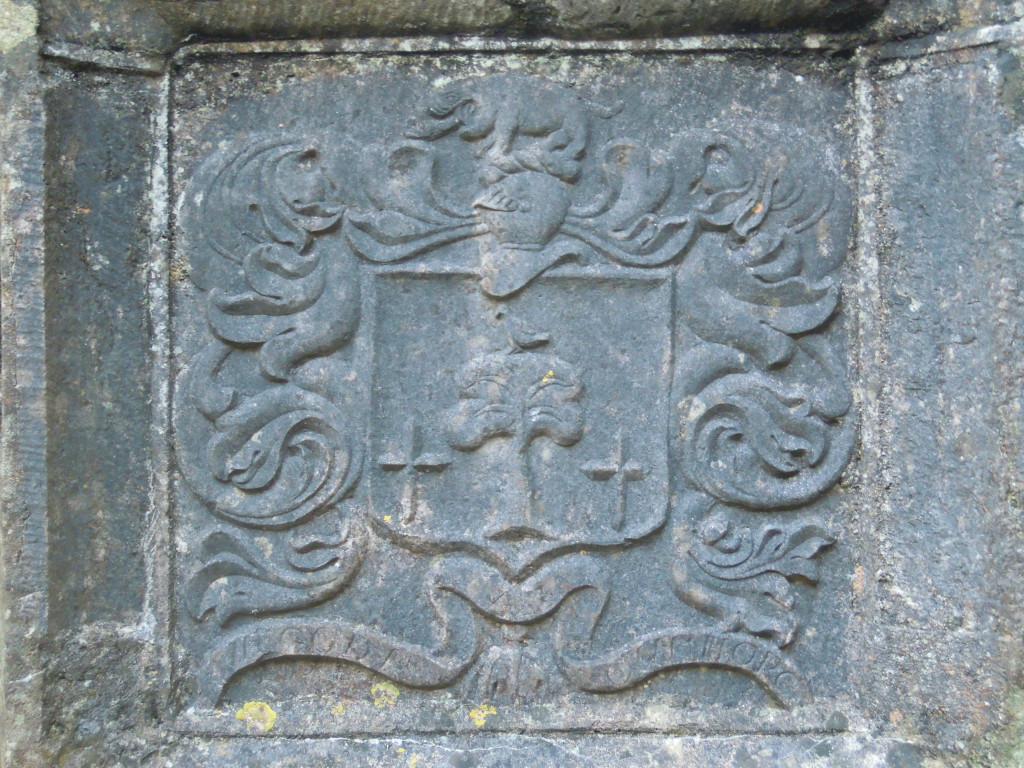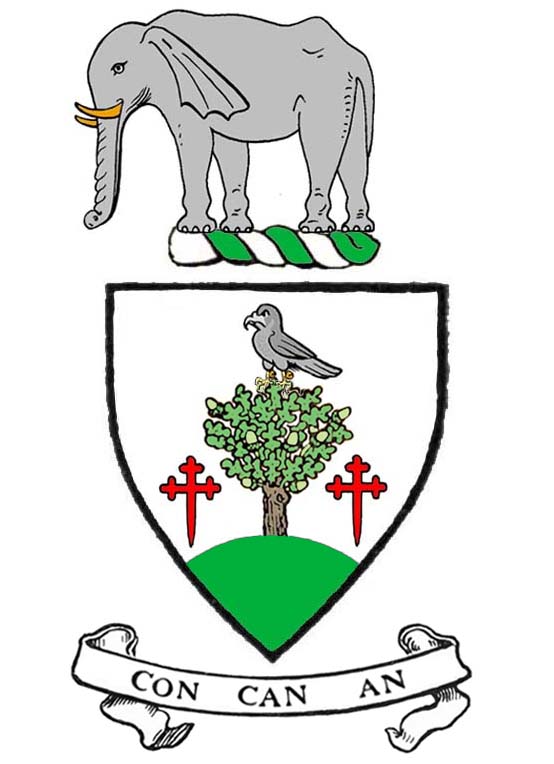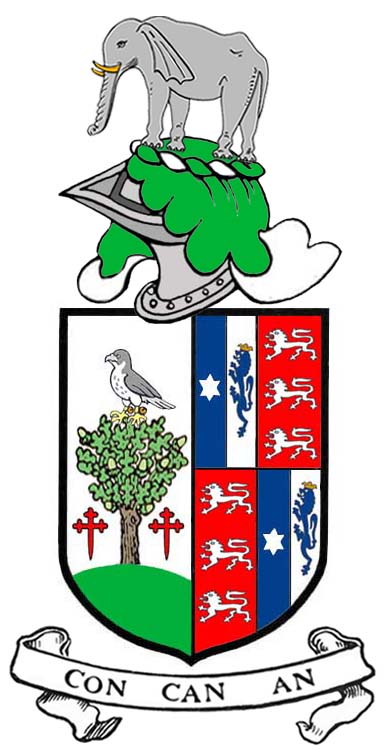© Donal G. Burke 2013
Set into the wall of the choir in the ruins of the medieval Carmelite abbey in Loughrea is a stone armorial tablet without any surviving associated inscription. The arms depicted thereon were executed in a style suggesting a date in the seventeenth or early to mid eighteenth century and are composed of a tree upon a mound, with a bird perched upon the former, forming the principal elements of the shield, and at base, two simple latin crosses in fess with each arm and its lower limb pointed. The arms are those of a principal family of the name Concannon and the crest carved upon a closed visored helmet in profile would appear, although carved in a primitive way, to be that of a tusked animal, more reminiscent of a boar than the elephant associated with later representations of various Concannon arms. It is conceivable, however, that, in the absence of first hand knowledge of the appropriate animal, what appears to be a long tongue issuing from the mouth of the animal is intended to represent the trunk of an elephant. The motto carved upon the scroll beneath would read ‘in God is all our hope.’
The seventeenth century O Clery ‘Book of Genealogies’ gives an early pedigree of ‘Ó Con Cenainn’ as belonging to the extensive Uí Bhriúin family group. This kin-group was reputed to descend from one Brian, son of one Eochaidh Muighmheadhóin and whose principal branch provided the O Connor Kings of Connacht at one time.
As evidenced by a later confirmation of arms by the Ulster King of Arms, the tree in the Loughrea armorial tablet was taken to have been an oak tree. This tree occurs as the principal charge in the arms of a number of prominent families believed in the seventeenth century to have been of Uí Bhriúin origin, such as O Conor Don, the O Donnellans, the MacGeraghtys, the O Flannagans and the O Concanons. While its use may originally have been intentional to indicate kin-ship, the oak tree, however, cannot be said to be exclusive to this kin-group as it occurs in other families unrelated to the above-mentioned and cannot be said to be an exclusive heraldic signifier of kinship with the O Connor Kings of Connacht as it does not appear in the arms of other families of that same kin-group such as the MacDermotts.
The O Concannons were given as descended from one Con ceanainn (from whom came the family name), son of Taidhg son of Muircertaigh son of Oilealla son of Aeda son of Datlaich son of Diermada finn son of Tomaltaigh son of Murgaile son of Innrechtoigh son of Muireadhach Muilleathan.[i] This latter individual was given as descended from ‘Duach galaigh’, youngest son of Brian son of Eochaidh Muighmheadhóin.’[ii] From this same line, but from Diermada finn’s brother Muirghiusa descended the senior line of the O Connor Kings of Connacht and the MacDermott sub-kings of Moylurg within the wider Ui Briuin family group.[iii]
The family branch of Con ceanainn son of Taidhg were established by the tenth century in an area that would be known as Uí Diarmada, about the later parish of Kilkerrin in North-east Galway.[iv] Con ceanainn’s father, Taidhg son of Muircertaigh, was described as ‘taoiseach’ or chieftain of Uí Diarmada at his death in battle in 971.[v]
In 1585 Morrartaghe O Concannon was O Concannon (ie. the chieftain of the family) and seated at Kiltullagh, beside a lough of the same name, in the parish of Kilkerrin, to the south-west of the modern village of Glenamaddy in County Galway.[vi] At that time their territory, known as ‘Eraght I Dermoda’ or ‘Oireacht Uí Diarmada’ (ie. ‘the inheritance of Diarmuid’), was included in the Composition of Connacht in the barony of Tiaquin and within the wider territory of Uí Maine or Hy Many for administrative purposes and comprised of twenty-three quarters of land.[vii]
A senior line of the family were confirmed lands further to the south, at Carrownacregg in the parish of Killoscobe, north of the modern village of Menlough in east Galway, following the restoration of the monarchy in the person of King Charles II in the late seventeenth century and the previous upheaval in land ownership in the Cromwellian period.
Sisby Concanon née Burke was granted the lands of Carrownacregg in 1678 by King Charles II. Her husband appears to have died before June of 1656 when as ‘Sissly Bourke alias Concannon’ she was decreed 56 profitable Irish acres by the Cromwellian authorities as a transplanted person. She had a son Edmond, whose son and heir John succeeded to Carrownacregg. John Concannon’s son Edmond of Carrownacregg married in 1745 Elinor, daughter of Thomas Cuniffe, Esq. of Ardroe, County Galway. He died in 1770, leaving as his successor his son Henry. By his wife Rachel, daughter of John Marshall, Esq. of Ballygaddy, near Tuam, Henry had at least two sons and two daughters; Edmond John, born in January 1792, James Henry, Elinor and Celia. He died in 1810 and was succeeded by his eldest son and heir Edmond John Concanon, who in 1815 married Jane, daughter of John Blake Esq. J.P. of Belmont House, County Galway.[viii]
In the early nineteenth century the Concannons, spelling their name as ‘Concanon,’ were seated at Waterloo House, a two-storied three bay house within the same parish but in the townland of Aghanahil, between the villages of Menlough and Castleblakeney.
Described as ‘descended from the Ancient Irish Sept of O Concanon long possessed of extensive property and high position in the Province of Connaught,’ Edmond John Concanon ‘of Waterloo, County of Galway, Esquire, formerly of Carrownacreggy in the same county, eldest son and heir of Henry Concanon of Carrownacreggy aforesaid, Esquire, deceased and grandson of Edmond Concanon also of Carrownacreggy, Esquire, likewise deceased,’ applied to the Ulster King of Arms for a confirmation of arms. On the 21st September 1854 John Bernard Burke, Ulster King of Arms, confirmed arms ‘which have been borne by his Ancestors time immemorial’ unto Edmond John Concanon, his descendants and the other descendants of his grandfather Edmond of Carrownacreggy, comprised of ‘Argent, on a mount Vert, an oak tree Proper perched thereon a falcon also Proper, belled Or, between in base two cross crosslets fitchée Gules. For crest, an elephant statant Proper, tusked Or and for motto ‘Coñ can an.’[ix]
In the register of the confirmation maintained in the office of the Ulster King of Arms, Burke placed an asterisk beside the motto ‘Coñ can an,’ referring the reader to the French motto handwritten below the blazon; ‘Sagesse sans tache.’ James Fairbairn in his ‘Crests of the Families of Great Britain and Ireland‘ gave this French motto as the motto of Concanon, translating it into the English language as ‘Wisdom without spot.’
By his wife Jane, Edmond John Concanon of Waterloo House had six sons and three daughters; Henry Concanon, Esq., LL.D., Q.C., barrister-at-law, of No. 9 Lower Gardiner Street, Dublin, who married in 1854 the Countess Maria Aurora Arabella de Lusi, daughter of Count de Luisi and died in 1869, John, who drowned in his youth in 1835, Edmond, James Blake Concanon, Anthony, George Blake Concanon, Sarah, Anna and Rachel Mary.[x]
The arms of Henry Concanon, Esq., B.A., of Lincoln’s Inn (later of Lower Gardiner Street, Dublin), Barrister-at-law, eldest son of Edmond John Concanon, Esq., of Waterloo, County Galway, after those given by Sir Bernard Burke, Ulster King of Arms in his 1863 edition of ‘A Selection of Arms Authorized by the Laws of Heraldry.’ In right of his wife, the Countess Maria Aurora Arabella de Lusi, daughter of Count de Lusi by his wife Maria Gifford, daughter of Maria, Marchioness of Lansdowne, Burke stated that Concanon impaled the quartered arms of de Lusi and Gifford. (Henry Concanon’s wife was granddaughter of Lady Gifford, who, on her second marriage in 1805, became Marchioness of Lansdowne).[xi] He was appointed Queen’s Counsel in 1868 and died in May of the following year.
Fox-Davies in his 1905 edition of ‘Armorial Families,’ gave the arms of Edmond Concanon of Waterloo, born about 1817, the third son of Edmond John Concanon of Carrownacregg and Waterloo by his wife Jane Blake as the same as those of his father with mantling of Vert and Argent.[xii]
This Edmond married Kate, daughter of Charles Parsons of Tuam and had issue; Edmond John Concanon, Circular Road, Tuam, Charles Concanon, Bermingham House, Tuam, James Blake Concanon, Annagh, Ballyglunin, Co. Galway, Henry John Concanon, The Grove, Tuam and George Blake Concanon, The Hazels, Streatham, London, all described with the rank of ‘gentleman.’[xiii] Edmond Concanon, like his elder brother Henry, pursued a legal career and established the law practice of ‘Concanon Co.’ in 1838 at Tuam. Following his death in 1902, his son Henry J. Concanon of The Grove, Tuam, a solicitor, would continue the practice and, while members of the Concanon family ceased to be involved in the running of the practice after the death of Henry Concanon, the practice continued into the twenty-first century under the name of ‘Concanon & Meagher.’
The same arms borne by Edmond Concanon, born about 1817, were described as those of George Lewis Blake Concanon, gent., 2nd Lieutenant, 4th Battalion of the Sherwood Foresters and Minor Scholar at King’s College Cambridge, the only son of William Augustus Concanon of Brisbane, Queensland, Australia, the only son of George Blake Concanon, LLD of Trinity College Dublin, brother of the above-mentioned Edmond Concanon of Waterloo and youngest son of Edmond John Concanon of Carrownacregg and Waterloo, Co. Galway. No differencing was given by Fox-Davies in his ‘Armorial Families.’
Extensive lands forming the Concanon estates were offered for sale in the Encumbered Estates Court in 1851. The Concanon lands at Carrownacregg were sold in that year to one James Browne, whose family retained ownership until the early twentieth century, whereupon the land was purchased by the Irish Land Commission.
[i] Pender, S., The O Clery Book of Genealogies: 23 D 17 (R.I.A.), Analecta Hibernica, No. 18, 1951, p. 89, no. 1108. ‘Genelach H. Con Ceanainn.’
[ii] Pender, S., The O Clery Book of Genealogies: 23 D 17 (R.I.A.), Analecta Hibernica, No. 18, 1951, p. 83, no. 1006. ‘Genelach Meic Diermada.’
[iii] Pender, S., The O Clery Book of Genealogies: 23 D 17 (R.I.A.), Analecta Hibernica, No. 18, 1951, p. 78, no. 928, p. 83, no. 1006.
[iv] Knox, H.T., The de Burgo Clans. The Clann David Burke and the Family of William, Sheriff of Connaught, J.G.A.H.S., Vol. 3, no. 1, 1903-4, pp. 55-6.
[v] Annals of the Four Masters.
[vi] O Flaherty, R., Ogygia: or, A chronological account of Irish events: collected from very ancient documents, (translated by Rev. James Hely), Vol. II, Dublin, W. M’Kenzie, 1793, Part III, Chapter LXVI, pp. 318-9.
[vii] O Flaherty, R., Ogygia: or, A chronological account of Irish events: collected from very ancient documents, (translated by Rev. James Hely), Vol. II, Dublin, W. M’Kenzie, 1793, Part III, Chapter LXVI, pp. 318-9.
[viii] Burke, Sir J. B., A Genealogical and Heraldic Dictionary of the Landed Gentry of Great Britain and Ireland, London, Harrison, 1858, p. 231; Calendar of the Manuscripts of the Marquess of Ormonde K.P., Presented at Kilkenny Castle, Vols. I, II, III, Historical Manuscripts Commissions, Fourteenth Report, Appendix, Part VII, London, Eyre and Spottiswode for Her Majesty’s Stationary Office, 1895, p. 122. ‘List of Transplanted Irish 1655-1659, No. 1, ‘An account of lands set out to the Transplanted Irish in Connaught.’
[ix] N.L.I., Dublin, G.O. Ms. 108, fol. 29.
[x] Burke, Sir J. B., A Genealogical and Heraldic Dictionary of the Landed Gentry of Great Britain and Ireland, London, Harrison, 1858, p. 231; Burke, O.J., Anecdotes of the Connaught Circuit, Dublin, Hodges, Figgis and Co., 1885, pp. 326-8.
[xi] Burke, Sir B., A Selection of Arms Authorized by the Laws of Heraldry, London, Harrison, 1863, pp. 121, 125-6, Plate XXV; Burke, O.J., Anecdotes of the Connaught Circuit, Dublin, Hodges, Figgis and Co., 1885, pp. 326-8.
[xii] Fox-Davies, A.C., Armorial Families, a directory of gentlemen of coat-armour, 5th edition, Edinburgh, T.C. & E.C. Jack, 1905, P. 299. Fox-Davies gives Edmund, born in 1817 as the fourth son of Edmond John and Jane Blake but both Sir Bernard Burke and Charles ffrench Blake Foster give him as the third son of his father and Blake Foster gives James Blake Concanon as the fourth son of his father. (Burke, Sir J. B., A Genealogical and Heraldic Dictionary of the Landed Gentry of Great Britain and Ireland, London, Harrison, 1858, p. 231.)
[xiii] Fox-Davies, A.C., Armorial Families, a directory of gentlemen of coat-armour, 5th edition, Edinburgh, T.C. & E.C. Jack, 1905, P. 299.




